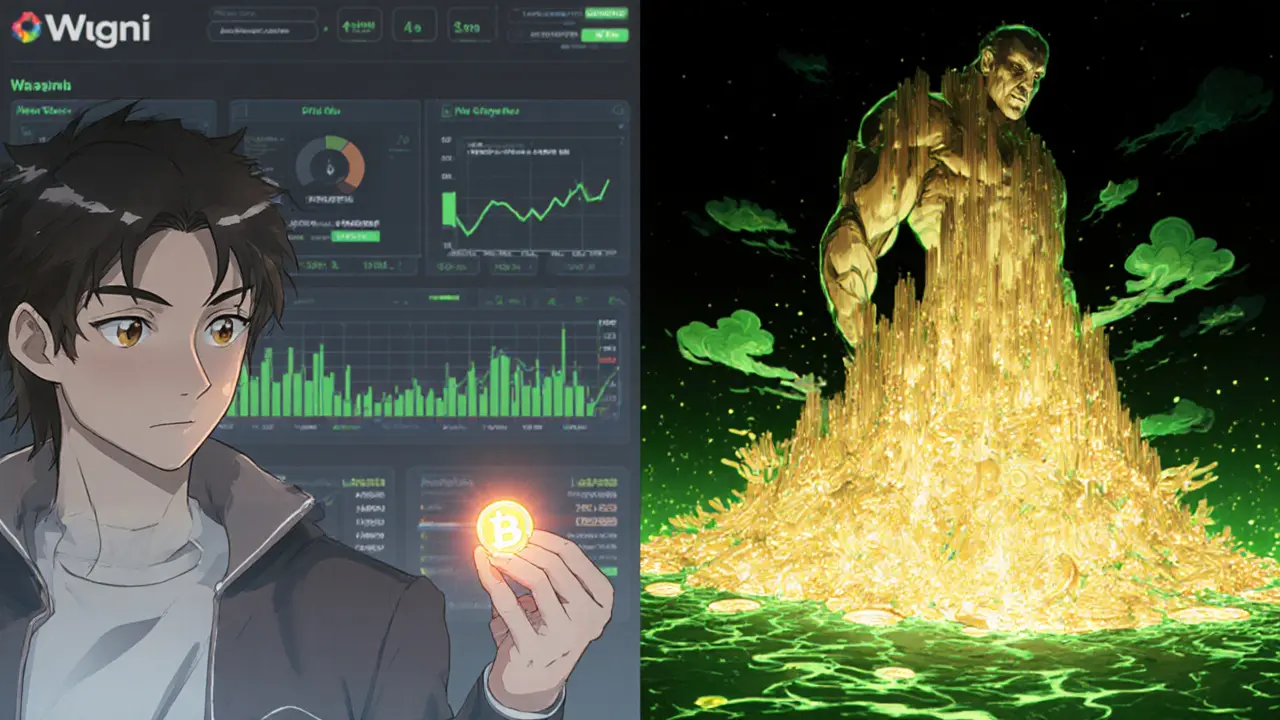Wagmi vs. Uniswap V4 Comparison Calculator
Wagmi Metrics
- Trading Volume (24h) $119
- Liquidity (TVL) Not disclosed
- Governance Token Planned
- Fees Undisclosed
Uniswap V4 Metrics
- Trading Volume (24h) $2.3M
- Liquidity (TVL) $250M
- Governance Token UNI
- Fees 0.30% swap fee
| Metric | Wagmi (zkSync) | Uniswap V4 (zkSync) |
|---|---|---|
| Launch Date | Early 2024 | Q2 2024 |
| 24-hr Trading Volume | $119 | $2.3M |
| Liquidity (TVL) | Not disclosed | $250M |
| Governance Token | Planned | UNI |
| Fees (Average) | Undisclosed | 0.30% swap fee |
Trading Volume Ratio
Wagmi Volume: $119
Uniswap Volume: $2,300,000
Ratio: 1 : 19,328
Liquidity Gap
Wagmi TVL: Not disclosed
Uniswap TVL: $250M
Gap: Over $250M
When exploring new Wagmi (zkSync Era) is a decentralized finance (DeFi) protocol that offers exchange‑like trading, liquidity provision, and automated strategy tools on the zkSync Era Layer2 network. It promises a “centralized‑exchange feel” while keeping the transparency of a blockchain. The question on every trader’s mind is whether it lives up to that promise or stays a niche experiment.
Understanding the zkSync Era foundation
The zkSync Era is a Layer2 scaling solution for Ethereum that uses zero‑knowledge rollups (ZK‑rollups) to bundle thousands of transactions into a single proof. By doing so, it slashes gas fees to a few cents and pushes throughput past 200TPS, making it attractive for DeFi apps that need cheap, fast swaps.
Because zkSync Era is fully EVM compatible - it runs Solidity contracts just like Ethereum, developers can port existing DEX code without rewriting the whole stack.
What Wagmi claims to deliver
- Exchange‑style trading: limit orders, market orders, and price charts that look like a traditional exchange UI.
- Liquidity provision: users can deposit assets into pools and earn a share of swap fees.
- Strategy generation: built‑in tools for automated yield‑optimizing tactics.
- One‑stop‑shop experience: combines swapping, lending, and staking under a single dashboard.
All of these features sit on top of a decentralized exchange (DEX) architecture, meaning there is no central custodian holding user funds.
Current market activity - the hard numbers
Data from on‑chain analytics shows a 24‑hour trading volume of $119.49 on Wagmi. That is a fraction of what even a modest DEX on zkSync Era processes daily (typically millions of dollars). There is no publicly available total value locked (TVL) figure for Wagmi, which makes it hard to gauge liquidity depth.
For context, the broader zkSync Era ecosystem holds over $795million in bridged TVL and roughly $430million in DeFi‑specific TVL. Institutional players like Deutsche Bank, Sygnum Bank and UBS have allocated funds to projects on zkSync Era, indicating a healthy macro environment. Wagmi, however, has yet to capture a meaningful slice of that pie.
Technical infrastructure - under the hood
Wagmi’s smart contracts are written in Solidity and compiled for the zkSync Era runtime. The protocol leverages the zero‑knowledge rollup mechanism to batch swaps, which reduces per‑transaction cost dramatically compared to Ethereum L1. Because zkSync Era offers full EVM compatibility, the same audit tools used for Ethereum contracts can be applied, though no public audit report for Wagmi has been released as of October2025.
The protocol also supports bridging from Ethereum, Optimism, and Arbitrum via a built‑in bridge UI. This way, users can move assets onto zkSync Era before interacting with Wagmi, keeping the overall experience “one‑click” for those already in the zkSync ecosystem.

Roadmap and multi‑chain ambitions
Wagmi’s team publicly states that once the protocol is “thoroughly tested and refined on the zkSync Era mainnet,” they will deploy an “omni‑layer” that can run on additional L2s and even L1s. No concrete dates have been announced, and the only concrete milestone so far is the launch on zkSync Era Mainnet in early 2024.
Future goals include:
- Introducing a native governance token to let LPs vote on fee structures.
- Launching liquidity mining programs to boost liquidity provision incentives.
- Supporting cross‑chain swaps via the upcoming omni‑layer.
Risks and red flags to watch
While the concept looks solid, a few practical concerns stand out:
- Extremely low liquidity: With only $119 of daily volume, slippage on any sizable trade will be painful.
- Lack of audit transparency: No public security audit means potential smart‑contract bugs are unverified.
- Scant public information: The team’s identities, funding sources, and detailed fee schedule are missing from official docs.
- Competitive pressure: Established zkSync DEXes like Uniswap V4 on zkSync already process millions daily, making it hard for Wagmi to attract users without a clear moat.
For anyone risk‑averse, it may be wiser to wait for a formal audit or for the protocol to demonstrate sustained liquidity before committing significant capital.
How to start using Wagmi (if you decide to)
- Set up a zkSync‑compatible wallet (e.g., MetaMask with zkSync RPC, Argent X, or zkSync Wallet).
- Bridge assets from Ethereum or another L2 into zkSync Era using the official zkSync Bridge (usually a few cents in fees).
- Navigate to Wagmi’s web UI. The first time you connect, you’ll be prompted to approve the router contract.
- Deposit the token you wish to trade into the Wagmi pool. If you’re just testing, start with a small amount (e.g., $10) to gauge slippage.
- Execute a market or limit order. The UI shows a price impact estimate; keep it under 1% for a smooth experience.
- If you want to earn fees, add liquidity to a pool. Watch the “LP rewards” tab for any announced mining incentives.
Remember, every transaction will still be recorded on the zkSync Era blockchain, so you retain full ownership of your assets.
Key Takeaways
- Wagmi is a DeFi protocol on zkSync Era that mimics a centralized exchange UI.
- Current on‑chain data shows only $119 of 24‑hour trading volume, indicating ultra‑low liquidity.
- The underlying zkSync Era network is robust, with >$795M bridged TVL and strong institutional backing.
- No public security audit or detailed fee schedule is available, raising safety concerns.
- If you’re curious, start with a tiny amount and watch for future liquidity mining or token‑governance launches.
Comparison Snapshot: Wagmi vs. Uniswap V4 on zkSync Era
| Metric | Wagmi (zkSync) | Uniswap V4 (zkSync) |
|---|---|---|
| Launch date | Early 2024 | Q22024 |
| 24‑hr trading volume | $119 | $2.3M |
| Liquidity (TVL) | Not disclosed | $250M |
| Governance token | Planned | UNI |
| Fees (average) | Undisclosed | 0.30% swap fee |
The table highlights how far Wagmi currently trails the market leader on the same layer‑2. Until the gap narrows, traders seeking deep liquidity should stick with proven venues.

Frequently Asked Questions
Is Wagmi a centralized exchange?
No. Wagmi runs as a decentralized exchange (DEX) on the zkSync Era blockchain. It only mimics the look and feel of a centralized platform.
What wallets work with Wagmi?
Any wallet that can connect to zkSync Era works - MetaMask (with zkSync RPC), Argent X, zkSync Wallet, and hardware wallets via Ledger support.
Are there any fees for trading on Wagmi?
Wagmi has not published a detailed fee schedule yet. Users can expect a small network fee (the zkSync rollup fee) and a protocol‑level swap fee, but exact percentages are unknown.
Has Wagmi been audited?
As of October2025, no public security audit report has been released. Prospective users should treat the platform as unaudited and proceed cautiously.
What is the roadmap for multi‑chain support?
The team plans an “omni‑layer” that would let Wagmi run on other L2s (Optimism, Arbitrum) and possibly L1s. No timeline has been announced; watch the project’s official Discord and Medium for updates.


11 Responses
The numbers they publish are too neat; there’s a good chance the team is hiding the real liquidity under a shell to lure early birds. You can almost smell the smoke of a coordinated pump‑and‑dump scheme already. Keep your eyes peeled for sudden spikes that aren’t backed by real usage.
Hey folks! 😄 I totally get the excitement about a new DEX looking like a centralized exchange, but those $119 volume figures are honestly scary low. If you dip your toe in, maybe start with a tiny amount and see how the slippage feels. Good luck and have fun exploring! 🚀
The data speaks for itself: Wagmi’s liquidity is negligible, and without a disclosed TVL you’re trading blind. Compared to Uniswap V4’s $250 M pool, the risk‑reward balance is heavily tilted toward risk. I’d advise waiting for a solid audit and clearer incentives before committing capital.
It’s almost theatrical how they hype a “centralized‑exchange feel” while the order book is essentially empty. The drama of a shiny UI can’t mask the brutal reality of massive slippage on any meaningful trade. Until they pull in serious depth, this project feels like a plot twist that never resolves.
Wagmi’s current liquidity is essentially a whisper compared with Uniswap V4, which means any decent trade will suffer noticeable slippage. Because the protocol runs on zkSync Era, transaction fees are cheap, but that advantage evaporates when you have to pay a large price impact. The absence of a disclosed TVL makes it impossible to estimate the depth of the order books. If you are looking to test the platform, start with a minimal amount-say $10 worth of ETH-to see the real‑world impact. Bridge your assets to zkSync using the official bridge; the fee is just a few cents, so it’s not a barrier. Once on zkSync, connect a compatible wallet such as MetaMask with the zkSync RPC endpoint or Argent X. Approve the router contract when prompted; this is a standard step for any DEX on a roll‑up. When you place a market order, the UI will show an estimated price impact-aim for under 1 % to avoid surprise costs. Limit orders give you more control, but remember that execution is still subject to the thin liquidity pool. If you want to provide liquidity, pick a pool with the highest existing volume on the platform, even if it’s small. Collect any early‑bird LP rewards that may be announced; these can compensate for the lower fee revenue. Stay tuned for the upcoming governance token launch, which should introduce voting rights and potentially higher incentives. The roadmap mentions an omni‑layer for multi‑chain support, but until that materialises, treat Wagmi as a zkSync‑only experiment. Keep an eye on community channels for audit updates, because a formal security review is still missing. In the meantime, compare the swap fee on Wagmi to the known 0.30 % on Uniswap V4 to gauge cost competitiveness. Overall, treat Wagmi as a sandbox for experimentation rather than a primary venue for large‑scale trading.
Nice rundown, Rajini. Starting small and watching the price impact is the safest way to test the waters.
One might wonder: does the silence of a missing audit echo louder than any marketing hype? In the realm of decentralized finance, transparency is not a luxury-it is a necessity; without it, risk becomes a vague specter, haunting every transaction, every deposit, every hope of profit.
From a philosophical standpoint, the very notion of a DEX that pretends to be a centralized interface raises questions about user expectations versus system capabilities. If the underlying infrastructure cannot support meaningful volume, the veneer of a sleek UI becomes merely an aesthetic distraction. Moreover, the lack of disclosed fee structures prevents traders from performing accurate cost‑benefit analyses. In practice, this means any sizable position could be eroded by hidden fees or slippage that the platform does not openly acknowledge. Therefore, while the concept is alluring, the execution appears premature, and prudent participants should demand clearer data before scaling their exposure.
Give it a cautious try with a small amount and see how it feels.
I hear you, Ben. Starting small is the smartest move when the numbers look shaky.
Let’s keep the discussion constructive; every new protocol needs community feedback to grow, but safety should always come first.